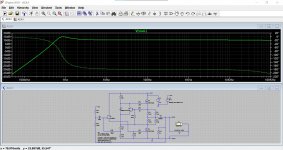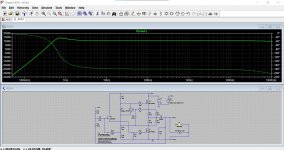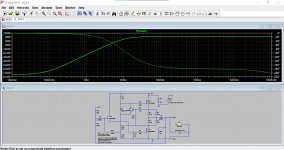^ What he said. I will also add that lead-acid batteries whether wet or AGM have a high output impedance, that gets worse as they are cycled multiple times. They are not a good power source for class A amplifiers. (Don't get started with car audio, that's a different area, where the builders use Farads of capacitance to overcome the limitation of lead acid batteries.)
For the question of 16Ω, 2 ACAs bridged into mono would be best as far as power delivery (each channel sees 8Ω) at the expense of higher Rout, not an issue if you are multi-amping as long as th ehorn impedance is not ugly on its own.
dave
The impedance isn't too bad, just high. I have one ACA and don't really want to build another just to try it. Did run the ACA some time ago and thought it was pretty good but my system and listening skills have improved since then...
Also have some MOFO boards sitting there so maybe should try them as well?
Try the ACA, then you will know. Since you are just driving the horn, do try connecting with skinny solid wire. Like strands pulled from CAT5/6 wall cable.
The MoFo is on my list, but the SIT-3 has likely trumped any SS builds. And i alread have boards for F2/4/5 and 2 Aleff variations.
dave
The MoFo is on my list, but the SIT-3 has likely trumped any SS builds. And i alread have boards for F2/4/5 and 2 Aleff variations.
dave
So I get it that you don’t want the amp starved for power for big transients, etc. , and it’s not a powerful amp so that seems reasonable. However it is a single ended class A amp which are the most inefficient there are. (which is why it sounds so good!) But it gets worse, it draws almost full power All The Time. One byproduct of that is it isn’t very starved for power in most cases because the power supply has to be “oversized” to accommodate this constant power flow. And it doesn’t really draw much more power for huge transients! The power is always there! This isn’t that obvious with the ACA but only because it isn’t a big amp. The 24v 5.5A PSU currently supplied with the ACA kit might be a bit oversized. But if you wanted 100wpc, the equivalent PSU would draw over 1500 watts! I think...
I know what you mean by “inrush currents” but the term inrush usually used for the moment when you turn on an amp and a large jolt of electricity “rushes” into the power supply to charge up the capacitors, etc. This sudden jolt can be hard on the PSU components but can also damage components much further along in the amp, either suddenly or over time. So generally people want to Limit inrush!
I know what you mean by “inrush currents” but the term inrush usually used for the moment when you turn on an amp and a large jolt of electricity “rushes” into the power supply to charge up the capacitors, etc. This sudden jolt can be hard on the PSU components but can also damage components much further along in the amp, either suddenly or over time. So generally people want to Limit inrush!
Has anyone talked about replacing the power adaptors for the ACA with batteries ? I'm assuming a battery source will have much better power source on demand (eg. high inrush currents).
Last edited:
… it is a single ended class A amp which are the most inefficient there are. (which is why it sounds so good!) … the ACA but only because it isn’t a big amp.
Worth mentioning that the ACA clips very gracefully. That allows it to sound much more powerful than you'd guess.
Something i learned decades ago when a 20w amp exhibited audible clipping after a 200w amp got quit eobnoxious.
Try it.
dave
Bridged/balanced should have canceled 2nd order (not necessarily a positive thing), one ideally wanted 2nd higher than 3rd. It will also have double the Rout. Each channel see half the load, so if the speaker is (nominal) 16Ω, each channel sees 8Ω
Parallel should will have much the same harmonic spectrum. But 2 output devices that are not exactly the same will not be as capable with the really low level information/detai as it gets mooshed by the differences in each channels output. It will also have half the Rout. Each channel will effectivly see double the load, so if the speaker is (nominal) 4Ω, each channel sees 8Ω
The amp doubes in power. 8+8.
So vesatile, cheap, easy to build, and sounds great, but if you need more power (you may well be surprised by these) build a bigger amp.
I would not be surprised if it has become the most populas Nelson Pass amp ever.
dave
Parallel should will have much the same harmonic spectrum. But 2 output devices that are not exactly the same will not be as capable with the really low level information/detai as it gets mooshed by the differences in each channels output. It will also have half the Rout. Each channel will effectivly see double the load, so if the speaker is (nominal) 4Ω, each channel sees 8Ω
The amp doubes in power. 8+8.
So vesatile, cheap, easy to build, and sounds great, but if you need more power (you may well be surprised by these) build a bigger amp.
I would not be surprised if it has become the most populas Nelson Pass amp ever.
dave
According to Nelson, some people prefer 3rd order. It sounds more “analytical” , esp if the 2nd order is reduced. I suspect that you will prefer the higher 2nd order of stock or parallel. Doubling the power would certainly be noticeable, obviously not perceived as “twice as loud”, and will work better with some speakers. However the way the bridged circuit is done will increase the distortion a bit so it might all balance out. Would be fun to have a quick way to try all the variations of the monoblocks easily to see what you prefer.
Last edited:
And perhaps if the preamp is 2nd order forward you might want a bit less in the power amp and as you’ve mentioned the speaker impedance curve affects things too. Fun to try it different ways and see what works best for your preference and your system. I agree it is hard to predict.
Input capacitor C3
Hello,
Maybe someone already asked this question, I was not able to find an answer however so if it's asked previously I apologize.
I was wondering if I could place a 15uf cap on C3 instead of 10uf? Currently it's stocked with an 10uf audyn cap plus (very nice cap). I came across a good deal for two 15uf jantzen silver z caps so I couldn't help but wonder if I could throw those in.
Cheerz
Hello,
Maybe someone already asked this question, I was not able to find an answer however so if it's asked previously I apologize.
I was wondering if I could place a 15uf cap on C3 instead of 10uf? Currently it's stocked with an 10uf audyn cap plus (very nice cap). I came across a good deal for two 15uf jantzen silver z caps so I couldn't help but wonder if I could throw those in.
Cheerz
I see. Thanks for making things visual. The graph however suggests that since the rolloff is so low in the audio band that C3 can be much lower to obtain for example a roll off at let's say 10Hz. This makes me wonder why Nelson choose the 10uf value
I would like to think it's because its the most suitable vs cost effective part for the job
Physically large parts like caps have a much greater chance of pickup of stray radiated noise and hash, particularly when used in high impedance locations such as C3 here. This is a 0.047uF cap
If you go smaller in value then you push the point at which the input vs output phase difference becomes a factor (the dotted line). It is 180 degrees (right hand scale) out of phase over the audio band because the amp inverts.
At low frequency the phase shift increases.
This amp behaves differently to most because the AC feedback is taken from after the speaker coupling cap. So the amp tries to increase the output voltage (before the cap) to compensate as frequency falls. That means a small value cap would increase the probability of clipping at LF.
Attachments
- Home
- Amplifiers
- Pass Labs
- Amp Camp Amp - ACA



